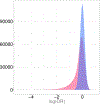Quantifying posterior effect size distribution of susceptibility loci by common summary statistics
- PMID: 32100375
- PMCID: PMC7502413
- DOI: 10.1002/gepi.22286
Quantifying posterior effect size distribution of susceptibility loci by common summary statistics
Abstract
Testing millions of single nucleotide polymorphisms (SNPs) in genetic association studies has become a standard routine for disease gene discovery. In light of recent re-evaluation of statistical practice, it has been suggested that p-values are unfit as summaries of statistical evidence. Despite this criticism, p-values contain information that can be utilized to address the concerns about their flaws. We present a new method for utilizing evidence summarized by p-values for estimating odds ratio (OR) based on its approximate posterior distribution. In our method, only p-values, sample size, and standard deviation for ln(OR) are needed as summaries of data, accompanied by a suitable prior distribution for ln(OR) that can assume any shape. The parameter of interest, ln(OR), is the only parameter with a specified prior distribution, hence our model is a mix of classical and Bayesian approaches. We show that our method retains the main advantages of the Bayesian approach: it yields direct probability statements about hypotheses for OR and is resistant to biases caused by selection of top-scoring SNPs. Our method enjoys greater flexibility than similarly inspired methods in the assumed distribution for the summary statistic and in the form of the prior for the parameter of interest. We illustrate our method by presenting interval estimates of effect size for reported genetic associations with lung cancer. Although we focus on OR, the method is not limited to this particular measure of effect size and can be used broadly for assessing reliability of findings in studies testing multiple predictors.
Keywords: approximate Bayes methods; p-values; prior distributions; strength of evidence.
© 2020 Wiley Periodicals, Inc.
Conflict of interest statement
Conflict of Interest
We have no conflicts of interest to declare.
Figures


Similar articles
-
Folic acid supplementation and malaria susceptibility and severity among people taking antifolate antimalarial drugs in endemic areas.Cochrane Database Syst Rev. 2022 Feb 1;2(2022):CD014217. doi: 10.1002/14651858.CD014217. Cochrane Database Syst Rev. 2022. PMID: 36321557 Free PMC article.
-
A bayesian method for evaluating and discovering disease loci associations.PLoS One. 2011;6(8):e22075. doi: 10.1371/journal.pone.0022075. Epub 2011 Aug 10. PLoS One. 2011. PMID: 21853025 Free PMC article.
-
An Empirical Bayes Mixture Model for Effect Size Distributions in Genome-Wide Association Studies.PLoS Genet. 2015 Dec 29;11(12):e1005717. doi: 10.1371/journal.pgen.1005717. eCollection 2015 Dec. PLoS Genet. 2015. PMID: 26714184 Free PMC article.
-
Empirical Bayes interval estimates that are conditionally equal to unadjusted confidence intervals or to default prior credibility intervals.Stat Appl Genet Mol Biol. 2012 Feb 21;11(3):Article 7. doi: 10.1515/1544-6115.1765. Stat Appl Genet Mol Biol. 2012. PMID: 22499708
-
Bayesian methods in health technology assessment: a review.Health Technol Assess. 2000;4(38):1-130. Health Technol Assess. 2000. PMID: 11134920 Review.
References
-
- Alenazi AA, Cox A, Juarez M, Lin W-Y, and Walters K (2019). Bayesian variable selection using partially observed categorical prior information in fine-mapping association studies. Genetic epidemiology, 43(6):690–703. - PubMed
-
- Benjamini Y and Hochberg Y (1995). Controlling the false discovery rate: a practical and powerful approach to multiple testing. Journal of the Royal statistical society: series B (Methodological), 57(1):289–300.
-
- Berry DA and Hochberg Y (1999). Bayesian perspectives on multiple comparisons. Journal of Statistical Planning and Inference, 82(1–2):215–227.
-
- Chen D, Jiang X, Akula N, Shugart Y, Wendland J, Steele C, Kassem L, Park J, Chatterjee N, Jamain S, et al. (2013). Genome-wide association study meta-analysis of European and Asian-ancestry samples identifies three novel loci associated with bipolar disorder. Mol. Psychiatry, 18(2):195–205. - PubMed
Publication types
MeSH terms
Grants and funding
LinkOut - more resources
Full Text Sources

